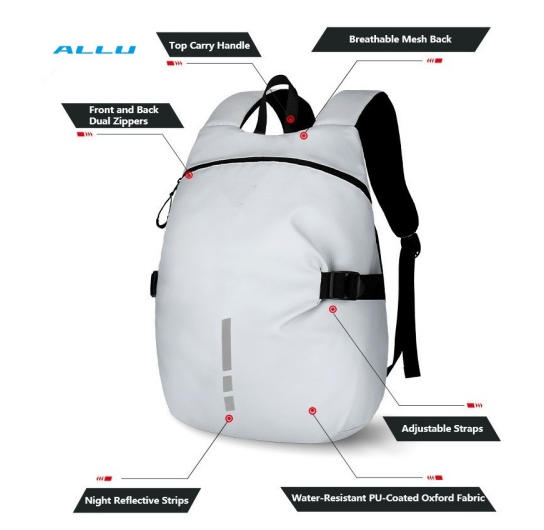For many cyclists, the backpack is more than a storage tool—it’s an essential part of every ride. Whether you’re commuting, touring, or training, the right cycling backpack ensures balance, comfort, and convenience. However, not all backpacks are designed with the same purpose. To help you choose the most suitable one, let’s explore the key features that define an ideal cycling backpack, with a close look at capacity, comfort, waterproofing, and structure.

When it comes to choosing a Large Capacity Riding Sport Backpack, the first factor to consider is volume. The backpack should provide enough space for daily essentials—helmet, gloves, repair kit, water bladder, and extra clothes—without becoming bulky or unstable.
| Riding Type | Recommended Capacity | Common Usage | Example Item |
| Urban Commuting | 15–20L | Laptop, raincoat, lunch box | Slim commuter pack |
| Long-Distance Touring | 25–35L | Extra clothes, hydration pack, tools | Large Capacity Riding Sport Backpack |
| Mountain Biking | 10–18L | Compact gear, energy bars, repair tools | Trail hydration pack |
The ideal backpack weight (when empty) should not exceed 1.2 kg, as added weight directly affects balance and shoulder fatigue during long rides. Backpacks using high-density nylon or TPU-coated polyester usually maintain strength while remaining lightweight.
Cycling involves constant motion and forward leaning. A well-designed Padded Back Compartment Backpack Lightweight can make a major difference. The padding isn’t just for comfort—it also ensures ventilation and pressure distribution.
Key ergonomic elements include:
Airflow Channels: A ventilated back panel reduces sweating by up to 25% according to 2024 cycling gear studies.
Shoulder Strap Design: Contoured straps with adjustable sternum and waist belts stabilize the backpack even at high speeds.
Padding Density: High-density EVA foam provides both cushioning and structure retention under load.
| Feature | Benefit | Ideal Range / Material |
| Back Padding Thickness | Absorbs shocks & protects back | 10–15 mm EVA foam |
| Shoulder Strap Width | Distributes pressure | 5–7 cm |
| Ventilation Channel Depth | Promotes airflow | ≥ 2 cm |
| Total Backpack Weight | Improves mobility | < 1.2 kg |
A Padded Back Compartment Backpack Lightweight design is especially helpful for urban riders who carry electronics, as it prevents impact damage and keeps posture balanced.
Weather is unpredictable. A Waterproof Cycling Storage Backpack provides confidence in any condition, keeping electronics and clothes dry. Look for backpacks with:
Waterproof coating (TPU or PU layer)
Sealed zippers
Roll-top closures
| Waterproof Rating | Description | Suitable Use |
| IPX3 | Light rain | Short commutes |
| IPX5 | Moderate rain | Daily cycling |
| IPX7 | Heavy rain / Immersion | Mountain or touring rides |
Backpacks with welded seams (instead of stitched) have 40–50% higher waterproof integrity.
A roll-top Waterproof Cycling Storage Backpack can withstand sustained rainfall while maintaining easy access to the main compartment.
Cycling backpacks are most efficient when every item has its place. Riders often look for smart compartment layouts—such as quick-access side pockets, tool pouches, and hydration sleeves.
Recommended organizational zones:
Main compartment: Clothing or helmet storage
Secondary zone: Laptop or hydration bladder
Front pocket: Tools, keys, energy gels
Hidden security pocket: Wallet or phone
An ideal cycling backpack should let you grab tools or snacks without dismounting your bike. Side zippers or quick-pull loops make this even more practical during fast rides.
Cycling safety extends beyond reflectors on your bike. Backpacks play a role too.
A professional-grade model includes reflective strips, LED light mounts, or fluorescent panels that enhance visibility during night rides.
According to 2024 data from the European Cycling Safety Board, reflective gear can reduce nighttime accident risk by 35%. Adding reflective trims on the backpack enhances visibility from multiple angles, particularly for urban riders.
Cycling backpacks undergo constant tension, vibration, and exposure to the elements. The most durable options use:
Ripstop nylon (400D–600D)
TPU coating for waterproof performance
YKK zippers for longevity
For commuters or professional riders, durability equals reliability—no tears or zipper failures in the middle of a journey.
Modern cyclists care about design as much as performance. The best cycling backpacks blend minimalist aesthetics with utility. Clean lines, muted colors, and integrated straps make them suitable for both office and outdoor environments.
For example, a Large Capacity Riding Sport Backpack with modular strap design can adapt between city commuting and long-distance travel without compromising style.
A high-quality cycling backpack is not just gear—it’s an extension of your riding system. It keeps your essentials safe, your posture aligned, and your mind focused.If you frequently ride in mixed weather conditions, prioritize a Waterproof Cycling Storage Backpack with a strong frame and breathable back support. For daily commuting, a Padded Back Compartment Backpack Lightweight will reduce fatigue and protect your laptop or electronics.
Ultimately, the right backpack transforms your cycling experience from “carrying” to “performing.” Whether you’re a city commuter or a weekend adventurer, investing in the proper design, capacity, and protection ensures comfort and confidence on every ride.
Leave A Message
Scan to WhatsApp :
